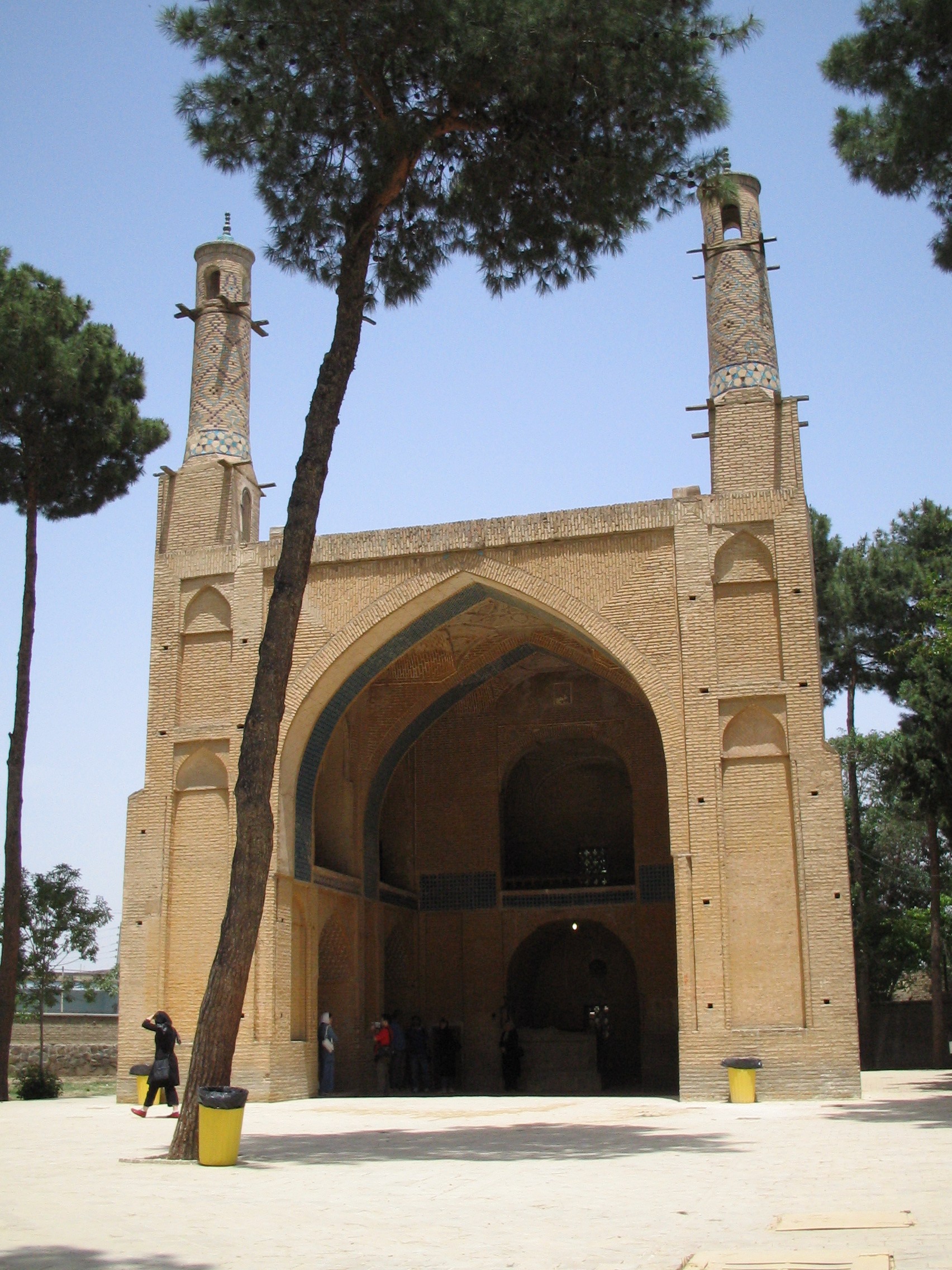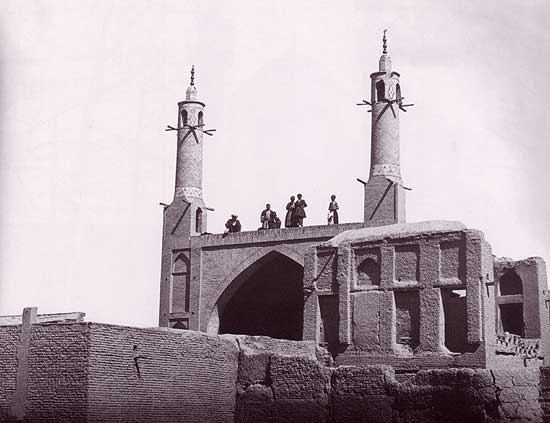Monar Jonban on:
[Wikipedia]
[Google]
[Amazon]
 The Monar Jonban (
The Monar Jonban (
 The minarets are responsible for the fame of the otherwise architecturally undistinguished shrine. Because of the ratio between the height and width of the minarets and the width of the ''iwan'', if one minaret is shaken, the other will shake in unison. This example of coupled
The minarets are responsible for the fame of the otherwise architecturally undistinguished shrine. Because of the ratio between the height and width of the minarets and the width of the ''iwan'', if one minaret is shaken, the other will shake in unison. This example of coupled
File:Monar Jonban Isfahan Aarash (22).jpg, Front view
File:Monar Jonban Isfahan Aarash (7).jpg, View under the porch arch
File:Monar Jonban Isfahan Aarash (16).jpg, Ancient tombstone
File:Monar Jonban Isfahan Aarash (4).jpg, A near view of the left minaret
File:Monar Jonban Isfahan Aarash (5).jpg, A near view of the right minaret
File:Monar Jonban Isfahan Aarash (15).jpg, A view from inside
File:Rocking Minarets of Isfahan.jpg, Monar Jonban, Isfahan
Isfahan.org: photo
More Photos, Tishineh
{{Isfahan Province Buildings and structures completed in 1316 14th-century mosques Mosques in Isfahan Safavid architecture Towers in Iran 14th-century architecture
 The Monar Jonban (
The Monar Jonban (Persian
Persian may refer to:
* People and things from Iran, historically called ''Persia'' in the English language
** Persians, the majority ethnic group in Iran, not to be conflated with the Iranic peoples
** Persian language, an Iranian language of the ...
: منار جنبان, meaning shaking minarets), is a monument located in Esfahan
Isfahan ( fa, اصفهان, Esfahân ), from its ancient designation ''Aspadana'' and, later, ''Spahan'' in middle Persian, rendered in English as ''Ispahan'', is a major city in the Greater Isfahan Region, Isfahan Province, Iran. It is lo ...
, in central Iran
Iran, officially the Islamic Republic of Iran, and also called Persia, is a country located in Western Asia. It is bordered by Iraq and Turkey to the west, by Azerbaijan and Armenia to the northwest, by the Caspian Sea and Turkmeni ...
. Construction began in the 14th century Safavid
Safavid Iran or Safavid Persia (), also referred to as the Safavid Empire, '. was one of the greatest Iranian empires after the 7th-century Muslim conquest of Persia, which was ruled from 1501 to 1736 by the Safavid dynasty. It is often conside ...
or Ilkhanate
The Ilkhanate, also spelled Il-khanate ( fa, ایل خانان, ''Ilxānān''), known to the Mongols as ''Hülegü Ulus'' (, ''Qulug-un Ulus''), was a khanate established from the southwestern sector of the Mongol Empire. The Ilkhanid realm, ...
dynasties of Iran
Iran, officially the Islamic Republic of Iran, and also called Persia, is a country located in Western Asia. It is bordered by Iraq and Turkey to the west, by Azerbaijan and Armenia to the northwest, by the Caspian Sea and Turkmeni ...
to cover the grave of Sufi
Sufism ( ar, ''aṣ-ṣūfiyya''), also known as Tasawwuf ( ''at-taṣawwuf''), is a mystic body of religious practice, found mainly within Sunni Islam but also within Shia Islam, which is characterized by a focus on Islamic spirituality, ...
''Amu Abdollah Soqla''. Its notable feature is that if one of the minaret
A minaret (; ar, منارة, translit=manāra, or ar, مِئْذَنة, translit=miʾḏana, links=no; tr, minare; fa, گلدسته, translit=goldaste) is a type of tower typically built into or adjacent to mosques. Minarets are generall ...
s is shaken, the other minaret will shake as well.
History
The ''iwan
An iwan ( fa, ایوان , ar, إيوان , also spelled ivan) is a rectangular hall or space, usually vaulted, walled on three sides, with one end entirely open. The formal gateway to the iwan is called , a Persian term for a portal projecting ...
(eyvān)'' and porch were probably erected shortly after 1316 under the Ilkhanate dynasty as a shrine for Sufi
Sufism ( ar, ''aṣ-ṣūfiyya''), also known as Tasawwuf ( ''at-taṣawwuf''), is a mystic body of religious practice, found mainly within Sunni Islam but also within Shia Islam, which is characterized by a focus on Islamic spirituality, ...
''Amu Abdollah Soqla'', a hermit buried here. The brick minarets were constructed later, and are probably of Safavid dynasty
The Safavid dynasty (; fa, دودمان صفوی, Dudmâne Safavi, ) was one of Iran's most significant ruling dynasties reigning from 1501 to 1736. Their rule is often considered the beginning of modern Iranian history, as well as one of th ...
era origin (c. 15th–17th centuries).
The ''iwan'' is high and in width, the minarets are taller and are in circumference. The roof above the shrine contains some skilled brickwork.
Shaking minarets
 The minarets are responsible for the fame of the otherwise architecturally undistinguished shrine. Because of the ratio between the height and width of the minarets and the width of the ''iwan'', if one minaret is shaken, the other will shake in unison. This example of coupled
The minarets are responsible for the fame of the otherwise architecturally undistinguished shrine. Because of the ratio between the height and width of the minarets and the width of the ''iwan'', if one minaret is shaken, the other will shake in unison. This example of coupled oscillation
Oscillation is the repetitive or periodic variation, typically in time, of some measure about a central value (often a point of equilibrium) or between two or more different states. Familiar examples of oscillation include a swinging pendulum ...
can be observed from ground level.
;Structural damage
The wooden beams on the upper part of the minarets have been placed there to facilitate the shaking of the minarets, but the presence of wood in the brickwork causes other complications. The repeated shaking has been responsible for considerable structural damage.
Shaking by visitors is in theory restricted to once every twenty minutes. However, particularly during holidays, there is a constant stream of people who experiment with the phenomenon. The damage is locally believed by some to have been incurred during the periods of occupation by British soldiers.
However, the most logical reason for the minarets to shake is the physical phenomenon of intensification or Doppler Effect
The Doppler effect or Doppler shift (or simply Doppler, when in context) is the change in frequency of a wave in relation to an observer who is moving relative to the wave source. It is named after the Austrian physicist Christian Doppler, who d ...
. Because the minarets are light and quite similar, shaking one affects the other. Tourists who have traveled to different parts of the world have introduced minarets in their observations that have the same characteristics in other parts of the world. But it is certain that the minarets of Isfahan are different from other moving minarets, and that is that in addition to the movement of the minarets, other parts of the building also move. Shake a brick minaret,
that never falls
;Imanshahr shaking minarets
There is another pair of shaking minarets also in Isfahan Province, at Imanshahr, of the earlier Ilkhanid dynasty
The Ilkhanate, also spelled Il-khanate ( fa, ایل خانان, ''Ilxānān''), known to the Mongols as ''Hülegü Ulus'' (, ''Qulug-un Ulus''), was a khanate established from the southwestern sector of the Mongol Empire. The Ilkhanid realm ...
era. They were built during the time of ''Öljaitü
Öljaitü ( mn, , Öljaitü Qaghan, fa, اولجایتو), also known as Mohammad-e Khodabande ( fa, محمد خدابنده, ''khodābande'' from Persian meaning the "slave of God" or "servant of God"; 1280 – December 16, 1316), was the eig ...
'' (1280–1316). These have lost the upper two thirds of their height.
Gallery
See also
*Safavid art
Safavid art is the art of the Iranian Safavid dynasty from 1501 to 1722, encompassing Iran and parts of the Caucasus and Central Asia. It was a high point for Persian miniatures, architecture and also included ceramics, metal, glass, and gardens ...
* Iranian architecture
Iranian architecture or Persian architecture (Persian: معمارى ایرانی, ''Memāri e Irāni'') is the architecture of Iran and parts of the rest of West Asia, the Caucasus and Central Asia. Its history dates back to at least 5,000 BC w ...
References
External links
Isfahan.org: photo
More Photos, Tishineh
{{Isfahan Province Buildings and structures completed in 1316 14th-century mosques Mosques in Isfahan Safavid architecture Towers in Iran 14th-century architecture